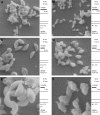Anti- Toxoplasma activity of various molecular weights and concentrations of chitosan nanoparticles on tachyzoites of RH strain
- PMID: 29563791
- PMCID: PMC5849388
- DOI: 10.2147/IJN.S158736
Anti- Toxoplasma activity of various molecular weights and concentrations of chitosan nanoparticles on tachyzoites of RH strain
Abstract
Background: Natural polysaccharides such as chitosan (CS) are widely used as antimicrobial agents. In recent years, and considering that CS has a strong antimicrobial potential, interest has been focused on antimicrobial activity of chitosan nanoparticles (CS NPs). The main factors affecting the antibacterial activity of chitosan include molecular weight (MW) and concentration. In this regard, the aim of this study was to produce various MWs and concentrations of CS NPs, through the ionic gelation method, and investigate their potential anti-parasitic activity against tachyzoites of Toxoplasma gondii RH strain.
Materials and methods: The MWs and degree of deacetylation of the CS were characterized using viscometric and acid-base titration methods, respectively. The efficacy of various MWs and concentrations of NPs was assessed by performing in vitro experiments for tachyzoites of T. gondii RH strain, such as MTT assay, scanning electron microscopy, bioassay in mice and PCR. In vivo experiment was carried out in BALB/c mice which were inoculated with tachyzoites of T. gondii RH strain and treated with various MWs of CS NPs.
Results: The results of in vitro and in vivo experiments revealed that anti-Toxoplasma activity strengthened as the CS NPs concentration increased and the MW decreased. In vitro experiment showed 100% mortality of tachyzoites at 500 and 1,000 ppm concentrations of low molecular weight (LMW) CS NPs after 180 min and at 2,000 ppm after 120 min. Furthermore, a 100% mortality of tachyzoites was observed at 1,000 and 2,000 ppm concentrations of medium molecular weight (MMW) CS NPs and at 2,000 ppm concentration of high molecular weight (HMW) CS NPs after 180 min. Growth inhibition rates of tachyzoites in peritoneal exudates of mice receiving low, medium and high MWs of CS NPs were found to be 86%, 84% and 79% respectively, compared to those of mice in sulfadiazine treatment group (positive control).
Conclusion: Various MWs of CS NPs exhibited great anti-Toxoplasma efficiency against tachyzoites of RH strain, with the greatest efficacy shown by LMW CS NPs in both experiments. It seems that CS NPs can be used as an alternative natural medicine in the treatment of toxoplasmosis.
Keywords: Toxoplasma gondii RH strain; chitosan nanoparticles; degree of deacetylation; molecular weights.
Conflict of interest statement
Disclosure The authors report no conflicts of interest in this work.
Figures




Similar articles
-
Successful treatment of acute experimental toxoplasmosis by spiramycin-loaded chitosan nanoparticles.Exp Parasitol. 2019 Sep;204:107717. doi: 10.1016/j.exppara.2019.107717. Epub 2019 Jun 20. Exp Parasitol. 2019. PMID: 31228418
-
The powerful synergistic effect of spiramycin/propolis loaded chitosan/alginate nanoparticles on acute murine toxoplasmosis.PLoS Negl Trop Dis. 2022 Mar 16;16(3):e0010268. doi: 10.1371/journal.pntd.0010268. eCollection 2022 Mar. PLoS Negl Trop Dis. 2022. PMID: 35294434 Free PMC article.
-
Promising In Vitro Anti-Toxoplasma gondii Effects of Commercial Chitosan.Infect Disord Drug Targets. 2021;21(1):151-155. doi: 10.2174/1871526520666200511004932. Infect Disord Drug Targets. 2021. PMID: 32389115
-
Effect of chitosan on Toxoplasma gondii infection: A systematic review.Parasite Epidemiol Control. 2020 Oct 21;11:e00189. doi: 10.1016/j.parepi.2020.e00189. eCollection 2020 Nov. Parasite Epidemiol Control. 2020. PMID: 33163635 Free PMC article. Review.
-
Chitosan Nanoparticles-Based Ionic Gelation Method: A Promising Candidate for Plant Disease Management.Polymers (Basel). 2022 Feb 9;14(4):662. doi: 10.3390/polym14040662. Polymers (Basel). 2022. PMID: 35215574 Free PMC article. Review.
Cited by
-
Synthesis, Characterization and Nanoformulation of Novel Sulfonamide-1,2,3-triazole Molecular Conjugates as Potent Antiparasitic Agents.Int J Mol Sci. 2022 Apr 11;23(8):4241. doi: 10.3390/ijms23084241. Int J Mol Sci. 2022. PMID: 35457059 Free PMC article.
-
Protoscolicidal effects of curcumin nanoemulsion against protoscoleces of Echinococcus granulosus.BMC Complement Med Ther. 2023 Apr 18;23(1):124. doi: 10.1186/s12906-023-03927-8. BMC Complement Med Ther. 2023. PMID: 37072845 Free PMC article.
-
Cytotoxic and Immunomodulatory Activity of Curcumin and Chitosan on Experimental Toxoplasmosis.Iran J Parasitol. 2024 Apr-Jun;19(2):224-237. doi: 10.18502/ijpa.v19i2.15858. Iran J Parasitol. 2024. PMID: 39011531 Free PMC article.
-
Metallic Nanoparticles and Core-Shell Nanosystems in the Treatment, Diagnosis, and Prevention of Parasitic Diseases.Pathogens. 2023 Jun 17;12(6):838. doi: 10.3390/pathogens12060838. Pathogens. 2023. PMID: 37375528 Free PMC article. Review.
-
Methods for the Characterization of Protein Aggregates.Methods Mol Biol. 2022;2406:479-497. doi: 10.1007/978-1-0716-1859-2_29. Methods Mol Biol. 2022. PMID: 35089576
References
-
- Dubey JP. Toxoplasmosis of Animals and Humans. 2nd ed. New York: Boca Raton; 2010. pp. 1–313.
-
- Tuazon CU. Toxoplasmosis in AIDS patients. J Antimicrob Chemother. 1989;23:77–82. - PubMed
MeSH terms
Substances
LinkOut - more resources
Full Text Sources
Other Literature Sources

